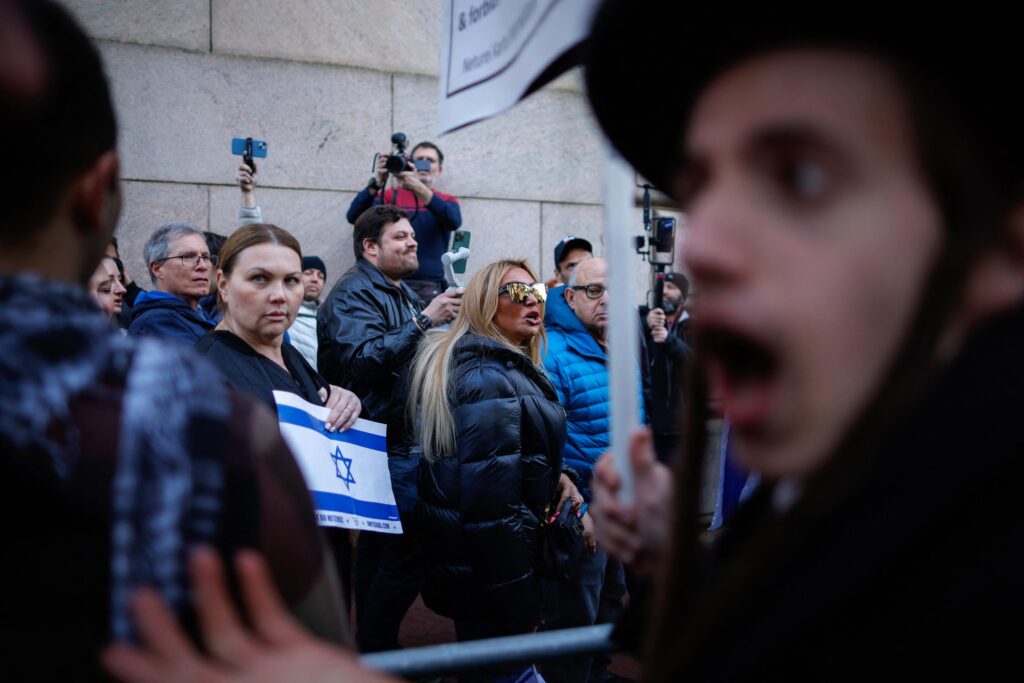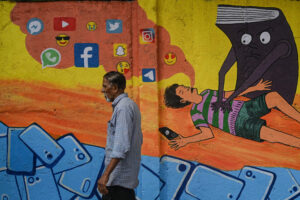Seeing Gaza Clearly

In our era of algorithm-driven social media markets, it is hardly surprising that the representation of events in Gaza and how those play out across U.S. college campuses exist in highly bifurcated silos. It is more disappointing, if also predictable, that so much mainstream media has failed to bridge that gap.
There is a fairly easy story to tell here. Atrocities are being committed in a foreign land. U.S. taxpayer dollars are arming and funding those atrocities. The historical context of the current events is a point of contestation. A mass movement has emerged with the university campus as its epicenter. The calls are familiar and draw on a rich history of U.S. civic organizing and successful drives for justice, equality, peace, free speech and international solidarity. In response, much of the political class recoils in shock and pulls up the drawbridge. Later on, enough of that same class often catches up to shift policy significantly towards the demands of the protesters (as seen with civil rights, Vietnam, anti-apartheid activism on South Africa and the Iraq War). Such movements always contain a misguided fringe prone to excess, hateful hyperbole and infiltration. This fringe is celebrated by those most committed to vilifying the cause of the protest movement.
So far, rather standard fare.
Two factors add a layer of complication to events: Firstly; this is about Israel, always prone to exceptionalism in American politics. Secondly, and linked, there are at least four simultaneous political struggles going on here—each distinct but heavily overlapping and interwoven.
The one that is getting the most attention is the role of antisemitism in the protests and the safety of Jewish students. Antisemitism matters. The 2018 deadly shooting at the Tree of Life synagogue in Pittsburgh was real. “Jews will not replace us” chants are de rigueur at white nationalist marches. And opposition to Israel can, on occasion, manifest itself as animus to Jews.
If one follows the US congressional hearings of university presidents, the statements of the Israeli prime minister and sometimes even those of the American president, as well as much of the mainstream media, one is given the impression that U.S. campus life is in the throes of an anti-Jewish hate fest.
But this is not true. It offers a dangerous and twisted distortion of what is taking place. Jewish students—openly and proudly proclaiming their Jewishness—are almost invariably at the center of these protests. Meanwhile, a cottage industry has sprung up of made-for-social media, pro-Israel agitation—substituting breadth of support with depth of ostentatious displays of provocation. This is not to make light of those occasions where the line has been crossed and actual antisemitic aggression has been on display. But it is extremely ill-advised and bodes very badly that U.S. President Joe Biden, members of his administration and some congressional Democrats have given oxygen to a broad smear campaign against mostly young people who are feeling their way in politics while on the most unforgiving of learning curves.
The boundaries of that debate around antisemitism will be returned to shortly. If one is looking for manifestations of hatred, then the anti-genocide, pro-ceasefire crowd are probably not the place to start. Navigating this terrain becomes more manageable when one understands the other vectors in play in the battles consuming American colleges.
For some of the protagonists on the right (including the authoritarian, pro-Trump and anti-intellectual right) antisemitism and the question of Palestine have served as a very convenient opportunity around which to advance a pre-existing agenda. That could include, for instance, removing federal funding from universities and restricting immigrant visas.
The overall effort is an almost timeless one against critical inquiry. Its current incarnation focuses on restricting places of learning from revisiting America’s history of racial and other oppression—the so-called anti-woke agenda. It is part of a cultural war that is considered electorally advantageous.
The legacy Jewish establishment groups, deeply embedded in pro-Israel advocacy, are making common cause with this effort. This in itself should barely raise an eyebrow. After all, the Anti-Defamation League infiltrated anti-apartheid groups during the struggle for equality in South Africa last century. Israel’s closest allies in the West are to be found among the anti-immigrant xenophobes of the popular white nationalist right, whether in Viktor Orban’s Fidesz-led Hungary, Geert Wilder’s Party for Freedom in the Netherlands, or Italy’s governing far right. The same is true in the U.S. To dilute the discomfort of being on the side of bigoted reactionaries, Zionist groups are desperately clinging on to those respectable looking alliances which the political power of the Israel lobby can still deliver—including university boards and cowed college presidents and eager-to-please AIPAC aligned congressional offices.
A third space of contestation is, unsurprisingly, politics and policy around Israel/Palestine itself. American policy has long been complicit in Israel’s denial of Palestinian human rights and violations of international law. Israeli and international human rights groups (B’Tselem, Yesh Din, Human Rights Watch, and Amnesty International) have followed their Palestinian counterparts in making the legal designation that Israel is committing the crime of apartheid in its regime of control over the Palestinians. That, alongside the Israeli government’s increasingly unvarnished extremism, has raised the bar on the criminality of a policy of U.S. enabling—whether in international fora, direct military assistance or pressure on third parties.
For many, the role of bystander became unbearable with the horrors visited upon Gaza and the plausible violations of the Genocide Convention under consideration at the International Court of Justice (which has already called on Israel to take immediate provisional measures to prevent irreparable harm—and has been ignored by Israel). For students on campus, this imperative touches on the very spaces they inhabit at this moment in their lives, as they witness the hellscape, devastation and destruction of institutions of higher, and indeed all education in Gaza—where University campus life no longer exists.
That U.S. arms have continued to flow, including the almost unprecedented use of U.S.-supplied 2,000lb bombs, makes this a domestic policy issue. Appeals to America and Israel’s shared adversaries or democratic values just won’t cut it. Hence the resort to spurious accusations of antisemitism, and institutional disciplinary procedures such as expulsion and police interventions.
To accuse the students of failing to target their rage at Hamas or Iran or injustices elsewhere from Ukraine to Sudan to Haiti, is to miss the point. In none of those instances is the U.S. funding, arming and running political-diplomatic cover for a party credibly accused of war crimes (in fact Iran, Hamas, Russia and others are sanctioned by the U.S.). That is the exceptionalism in play here. That is where the specific call for universities to divest, where relevant, from any role in this conflict is a relevant action to promote.
Polls consistently show that American public opinion in general, and certainly among Democrats, does not align with the administration’s largely unequivocal support for Israel. An element of what we are witnessing can be understood as the continuation of a system of policing which has long characterized what is permissible in the U.S. debate around Palestine/Israel.
The fourth vector is an internal Jewish struggle. Peter Beinart has called this “the greatest transformation in American Jewish politics in half a century,” which, he contends, “will redefine American Jewish life for decades to come.” Accounts from the ground suggest that the second largest cohort of participants in the protests, after Palestinian and Arab Americans, are Jewish Americans. Some of the most significant off-campus mobilizations of the last half year have been Jewish-led, such as at the sit in at New York’s Grand Central Station.
Part of what makes this unprecedented is a determination by this cohort of Jews (not limited to the U.S.) to center debate not on a particular action in Gaza, the inequities of occupation, or amorphous peace processing. Rather the question on the table today is that of Zionism itself, or at least whether actual-existing Zionism can be compatible with democracy and equal rights for Palestinians, and with safety and security for Jews.
The protests mark a rebellion against liberal Zionism—a credo which barely exists in political terms in today’s Israel, and which has consistently failed to meaningfully challenge either the apartheid reality on the ground or the U.S. policies which enable its perpetuation.
Given the role Israel has come to assume in American Jewish life, there exists, for many, a genuine sense of disorientation. Over decades, Israel was embedded into almost every nook and cranny of American Jewish life. The documentary Israelism (predating the events of recent months), captures this phenomenon. Ironically, the main articulation of this effort began in the early 1990’s against the backdrop not of threats to Israel, but of alarm-inducing studies around the specter of Jewish American assimilation and establishment fears for Jewish continuity. Rather than invest in cultural or educational programming at home, Israel emerged as the Disneyland experience to fill the vacuum of belonging. That’s where the free trips to Israel Birthright program derives.
As Israel lurched further to the right, inevitably this programming followed suit—along with attempts to redefine antisemitism in increasingly Israel-centric terms. This was more about the needs of Israeli statecraft and PR (Hasbara), than about the experiences of American Jews and the threats they may face but it was the perfect (and very Zionist) accompaniment to an anti-assimilation drive. If Jews were endangered, they’d better stick together.
For the significant cohort of Jews for whom Israel became a kind of secular religion and ballast of identity, confronting today’s events and debates, is genuinely discombobulating. It makes sense that even while in the vast majority of instances there is no antisemitic or physical threat to Zionist Jews on campus, the dissonance that comes with a core sense of self having its logic and legitimacy upended can feel physically and emotionally wrenching. Mistakes are being made in not building bridges that more Jews can cross from confusion to questioning to re-positioning.
Zionist hegemony will not be easily surrendered. But that hegemony in itself was an a-historic thing, in Jewish terms. The attempt of the last half century or more to suggest that Jews are a monolith, to suppress argument and debate inside Jewish circles, is deeply un-Jewish. As Naomi Klein noted in a remarkable speech, Jews have fallen prey to worshipping the “false idol of Zionism.” Perhaps Zionism can be reimagined and redefined as part of a future transformation from apartheid to equality inside Israel-Palestine itself. But, for now, it is Zionism’s inability to offer a peaceful future for Palestinians and Jews alike that is under the microscope.
Which leads us back to how best to understand and confront antisemitism.
There has been a decades long attempt to define a new antisemitism in ways which boost the authoritarian anti-intellectual agenda, close down space for debate on Israel-Palestine, and delegitimize one side of the internal Jewish debate. Its centerpiece became the so-called IHRA definition and examples of antisemitism, refracting Jewish interests through the prism of Israeli interests. Not only did that effort criminalize Palestinian, Jewish and other non-Zionist/anti-Zionist organizing, it also increasingly emptied the accusation of antisemitism of meaning and by default strengthened an already insurgent hard right.
As the Israel advocacy spin-off benefits scaled new heights, the fight against actual antisemitism has not been going so well. Encouraging a militarized response on college campus will not serve student wellbeing—Jewish or non-Jewish. It didn’t have to be this way—negotiation and dialogue was the option pursued by university administrations at Brown, UC Irvine, Wesleyan.
The most serious effort to reverse this trend and to counter the IHRA was launched just over three years ago in a document entitled “The Jerusalem Declaration on Antisemitism (JDA).” The JDA was authored by some of the top scholars of Jewish history, antisemitism, Holocaust and genocide studies, and leaders in the field of Israel and contemporary Middle East studies from universities in the U.S., Israel and Europe, some 300 signatories. It feels like a necessary time to dust off that document.
The point of departure for the JDA is both how to strengthen the fight against antisemitism—clarifying what it is and how it is manifested—and to protect the space for open debate on Israel-Palestine. The JDA goes on to delineate that the Palestinian demand for justice, opposing Zionism, comparing Israel with other historical cases including settler colonialism or apartheid, calls for boycott, divestment and sanctions, and arguing for a variety of constitutional arrangements for Jews and Palestinians including full equality to all inhabitants between the river and the sea, are examples that, on the face of it, are not antisemitic. In other words, it offers an extremely useful tool for navigating today’s debates.
At the time of its release, core movements in Palestinian civil society saw the JDA as an important corrective and paper to engage with, while reiterating the unreasonableness of an expectation that Palestinian political discourse would center the question of antisemitism. These are issues which clearly resonate today and in fact point to the existence of a fifth area of contestation—one that is perhaps most overlooked in the upheaval of the current moment.
That is the intense discussions within Palestinian circles around defining the contours and strategies of their own struggle for liberation. This takes place against the backdrop of the collapse of the recognized Palestinian political institutions—the Palestine Liberation Organization and the Palestinian Authority—which have been co-opted and discredited, are unrepresentative and unanswerable to their own people.
The significance of this internal Palestinian struggle is barely acknowledged. It needs time and space to build broad consensus around its terms of engagement. Events have dictated that this movement building is taking place under conditions of mass killing of Palestinians over there and of being arrested, suspended, and kicked out of dormitories in U.S. colleges. It is a movement that will ultimately have to speak to the permanent presence of Israeli Jews and offer an alternative to actually-existing Zionism—one in which Jewish Israelis can thrive outside of the structures of dominance and supremacy. One in which Jews elsewhere will also have an interest and even a stake. This nascent movement is being asked to carry this weight of expectation in the least propitious of circumstances.
In offering an alternative to the violence and structural inequality of the status quo, in unpacking what a contemporary anti-apartheid struggle entails, it is a movement which will ultimately have to offer a more secure future for Palestinian and Jew alike from the river to the sea and from the East Coast to the West Coast.


